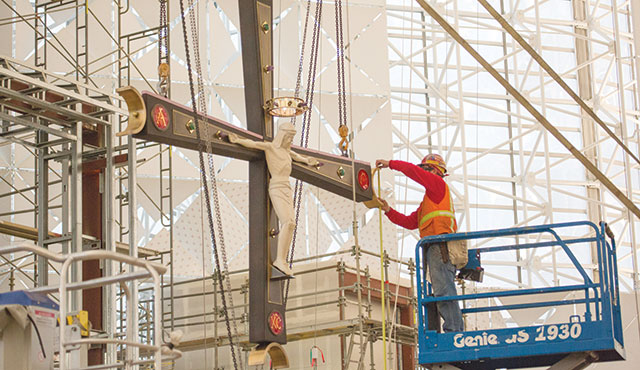Since last summer, when Christ Cathedral’s distinctive quatrefoils were installed to shade and buffer its 10,000 glass panes, significant progress is transforming the former Crystal Cathedral into a Catholic worship center.
Most recently the Hazel Wright Organ – the world’s fifth-largest organ and arguably its most famous – is being reinstalled so it ultimately can be voiced and tuned. In addition, the Crux Gemmata [giant crucifix] now hangs above the Italian marble altar on its stone predella, just in front of the matching Carrara marble Bishop’s Chair.
As work on the organ’s restoration continues, sacred art is being created by world-renowned artists, and original music commissioned for Christ Cathedral’s dedication events in July is being composed. The historic July 17 dedication also marks the first time the Catholic Church’s new Rite of Dedication will be used to dedicate a cathedral in an English-speaking country.
“If you were to enter the cathedral right now you would see workers installing and adjusting special spotlights and illumination over the altar, in the Blessed Sacrament Chapel, and the baptistery,” explains Episcopal Vicar Father Christopher Smith, rector of Christ Cathedral Parish.
“The stonework is finished, the walls are pretty much finished, and workers are doing some fine-tuning of the finish work where the stone walls meet the stone floors,” Fr. Christopher continues. “The baptistery pool was recently installed and they’re putting the stone cladding on it, and the decorative metal walls and chapel (designed by cathedral architects Johnson Fain) are installed.”
As John Romeri, the Diocese of Orange director of Music Ministries, awaits original compositions for the dedication events, he notes that the cathedral’s choir area is ready to go as soon as furniture arrives. Balcony pews are installed; plans are to install pews on the main floor in March.
Progress largely depends on the final installation of the organ’s thousands of parts – including more than 16,000 pipes, some of which are up to 32 feet long – that are now laid out and organized on the cathedral floor.
“Once the pipes are in and the electrical components are in place and everything in the organ is working, work can begin on the pipes themselves,” Romeri notes. “They will check the pitch, the tone, work on the voicing, and the last part is tuning the organ.”
Currently workers are installing the myriad mechanical parts of the organ, including the blowers and electronics and other complex mechanisms. Once the pipes are installed, each one will be adjusted for its own musical qualities as related to the cathedral building and uses. “The organ has to be voiced, which gives it its personality,” Father Christopher adds. “Some organs are brilliant, meaning high-toned in sound; others have a more bass sound. Voicing them, simply put, is like adjusting the treble and bass in your stereo system.”
Romeri anticipates voicing of the organ to begin in May. By early June, he says, most of the work must be underway or completed, because rehearsals for the choirs and musicians performing at the many dedication events will need to begin then.
Now that the building’s transformed infrastructure is in place, Fr. Christopher says, cathedral work crews are awaiting the arrival of sacred artworks, such as the 14 Stations of the Cross rendered in bronze by Bolivian-born artist Pablo Eduardo and the huge tapestry woven in Belgium depicting Jesus Christ King of the Universe, all of which will have their homes inside the cathedral.
Father Christopher expects to supervise installation of the sacred art and adjustment of lighting in the spring.
“It’s been fascinating to watch as the glass building has been transformed into a Catholic cathedral,” Father Christopher says. “It’s been quite a learning experience to watch and listen to all these experts at work. It’s given me a newfound respect for people in many trades.”
For instance, he notes, acousticians and mechanical engineers worked to balance reverberations and echoes to ensure that the organ, musicians, and many different choirs will be able to perform flawlessly inside the cathedral. Church experts worked to develop efficient traffic patterns for processions and distribution of the Eucharist.
Brother William Woeger, an artist, art consultant to Christ Cathedral, and a member of the Sacred Arts Commission, will arrive in the spring with many of the liturgical items, candles, candle stands and candlesticks he designed, which are being fabricated by Ironworks near his Omaha, Nebraska home.
For Father Christopher, the reality of the dedication just four months from now is beginning to dawn after more than five years of planning for Christ Cathedral’s transformation, he says.
“On that day, I will feel so grateful and proud that this is actually happening,” he says. “So many people have gone to such great lengths for this to happen. I’ll be thanking God for all the ways people’s lives will be uplifted to the Lord in such a beautiful space.”

